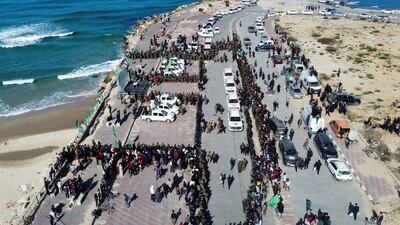US President Donald Trump’s assault on virtually every major institution in Washington has been, to a degree, successful.
There is a perverse logic behind his radical cabinet appointments, widespread dismissals and threats to the federal workforce, and his seemingly scattershot executive orders that upset apple carts up and down the street. Mr Trump’s intent is an overwhelming show of power, hitting on several fronts in order to disorient and demoralise his opponents.
While most of Mr Trump’s actions have been focused on the domestic front, and have served their purposes, he upped the ante by throwing in a few foreign policy zingers for good measure. He threatened to take back the Panama Canal, to force Denmark to sell Greenland to Washington, and to annex Canada into the US. As reactions from Panama, Denmark and Canada have made clear, none of Mr Trump’s foreign policy “tests” and challenges have had the same impact or success as his bullying forays into domestic policy.
In yet another quixotic foreign policy venture, Mr Trump threw a bombshell into the middle of the Palestinian-Israeli conflict. He proposed that it would be necessary to “clean out Gaza” before the reconstruction of the territory could begin. It’s been reported that in separate conversations with Jordan’s King Abdullah and Egyptian President Abdel Fattah El Sisi, Mr Trump pressed both to accept the bulk of Palestinians from Gaza, with Albania and Indonesia being tapped as back-ups to resettle others.
If Mr Trump’s goal was to shake things up and provoke a reaction, it flopped. None of the countries mentioned have agreed to participate in this bizarre scheme. And beyond a simple rejection, Palestinians have ignored Mr Trump’s bait, largely owing to their preoccupation with the emotional return to “their rubble” in Gaza’s north and with fighting off an increasingly aggressive occupation in the West Bank.
Let’s be clear: with negotiations having reportedly started for the second phase of the Gaza ceasefire, when reconstruction is supposed to get under way, some serious issues must be confronted. For example, there are 2 million homeless Palestinians and hundreds of thousands of demolished homes and buildings. It is estimated that it will take at least two or three years to remove or repurpose the rubble, and decades to build sufficient housing to accommodate those whose homes have been destroyed.
If one didn’t know Mr Trump, or his allies in Israel, one might think he was making a compassionate appeal to neighbours to shelter the homeless Palestinians until Gaza was ready to receive them. But that assumption doesn’t pass the smell test for several reasons. Mr Trump hasn’t given any indication that he is moved by the suffering of the Palestinians. He finds the prospects of building a resort on Gaza’s shores more appealing. At the same time, Israeli Prime Minister Benjamin Netanyahu’s coalition has made it clear that it wants to evict Palestinians from Gaza.
Given this, Mr Trump’s “suggestion” that Palestinians be moved to Egypt and Jordan seems to be more like providing his blessing for what would become a new Nakba. The first Nakba of 1948 saw the forced eviction of 700,000 Palestinians from their homes followed by Israel’s demolition of more than 420 Palestinian villages to ensure that they couldn’t return. This second Nakba would reverse the process, with Israel first demolishing entire residential areas in Gaza and then “transferring” 2 million Palestinians out of their country.
If the world has learnt anything in dealing with Mr Netanyahu, his coalition and their enablers in Washington, it’s best never to assume that they won’t do the worst thing possible. Mr Trump may either be attempting to bring his political power to bear on the Middle East or innocently floating an idea of transfer to facilitate reconstruction. But more probably he is floating a “trial balloon” for Mr Netanyahu, to test the region’s acceptance of a transfer plan to “solve” the Palestinian problem.
As I noted, with so much demanding their attention, neither Palestinians nor their supporters in the Arab world have yet reacted in full fury to Mr Trump’s “suggestion”. Nor has a plan been proposed to address how to clear the rubble and rebuild with 2 million Palestinians under foot.
For any such relocation and reconstruction plan to be accepted, at least two conditions must be met.
Israel must fully withdraw from Gaza, surrendering control of access and egress from the territory. This condition is imperative so that Palestinians can feel confident that if they leave Gaza, they are guaranteed the right to return. Another problem to be addressed is that some Palestinians returning from the south to the north are having difficulty identifying where their homes once stood. To avoid confusion or conflict, if municipal records no longer exist, an effort must be made to map Gaza, so that Palestinians can establish the location of their residence or business.
Without ironclad assurances of return and a plan to facilitate return to specific locations, efforts at relocation and reconstruction instead of solving a problem will only create deeper ones.
For more than a century, Palestinians have been pawns played by western powers and the Zionist movement. They have been dismembered, dispossessed and dispersed among the nations. Through it all, their national identity and attachment to their lands has only become stronger. Because of this, they have remained a persistent thorn in the side of those who oppress them.
It’s time for the US to recognise this reality and instead of compounding Palestinian suffering, it should develop a humane plan to end Israel’s veto over ending the occupation and implementing long-denied Palestinian rights.
Live updates: Follow the latest on Israel-Gaza


